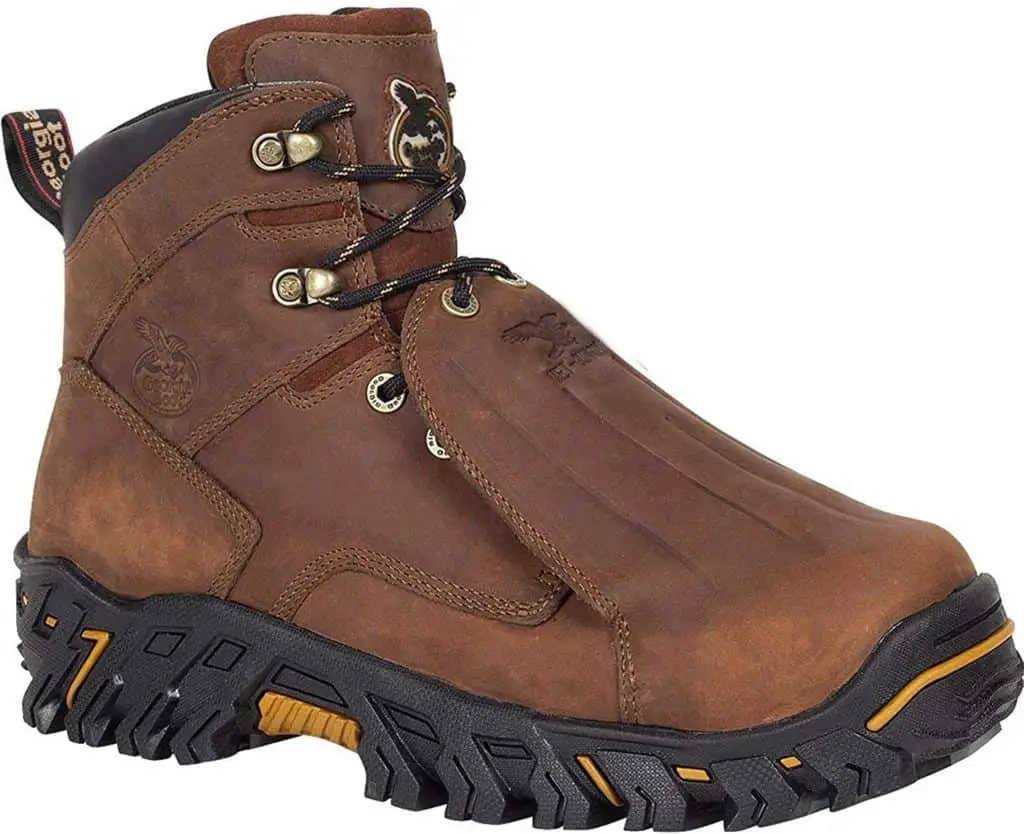When selecting metatarsal work boots, know that you have two options when it comes to boot type: either with external metatarsal guards or with internal metatarsal guards.
External Metatarsal Guards
The defining characteristic of work boots with external metatarsal guards is the fact that they are designed with a kind of external shell.
This shell will cover the boot work upper from the safety toe cap instep, covering work boot laces which is a plus if laces are at risk of getting caught on something.

This shell will be rigid, generally made from metal or plastic, will be wrapped in leather or some type of outer material, and will feature some type of padding or foam on the inside that aids in impact and shock absorption.
Because they are located on the outside of the work boot, they will cover a larger area than an internal Met Guard.
The dynamics of an external metatarsal guard see whatever is falling hit the outer rigid shell, while the internal foam padding absorbs the shock of impact, distributing it over the foot area increasing overall protection.
These are a great option for welders that also require foot protection from slags, sparks, or pieces of flying and falling metal.
They also protect from high temperatures that are characteristic of welding locations. They also give an added layer of protection for professionals using power-cutting tools against blades and accidental cuts.
Should a piece of heavy machinery roll over your foot, these external met guards will offer a bit more protection than internal met guards.
Limitations of External Metatarsal Work Boots
Because a protective shell is attached to the outside of your work boot, you may experience decreased flexibility when moving or walking.
Also, if you are required to climb ladders, these external shields can catch on them. New designs are attempting to better these aspects. Often external metatarsal guards can be removed if not necessary and reattached when needed.
Internal Metatarsal Guards
Work boots that feature internal met guards integrate these protective shields directly into the boot design beneath work boot laces.
Generally, two types of flexible, smaller internal met guard designs, that are less apparent or conspicuous than an external version, are used in internal metatarsal guard work boots.

An internal met guard uses a flexible scale type of design as in serpent skin that is wrapped in padding. This is positioned on top of the foot behind the work boot tongue.
Another design option is the use of a specially formulated urethane that absorbs shock and is likewise placed just behind the work boot tongue for impact absorption.
The material employed for shock absorption will tighten up when impacted suddenly. They will slow impact velocity and distribute impact energy over a wider surface
Some newer designs include a soft pouch of gel that upon impact hardens immediately thanks to a chemical reaction to protect the foot.
These internal met guards offer the same amount of protection as external met guards in cases of sudden impact injury.
Another major advantage with an internal met guard is style if this is a consideration for you. This is especially true if part of your work takes place off-site in an office or meetings with clients. The internal met-guard work boot will offer a sleeker aesthetic.
Depending on your profession, internal met guards may be better if when working you risk catching an external guard on a piece of machinery or equipment.
Limitations of Internal Metatarsal Work Boots
Despite the impressive capabilities of the materials used in internal met guards for impact protection, this type of guard is smaller, covering less area. Also, slow compression impact may be better served with external met guards.
The Metatarsal Must: The Why of Metatarsal Guards in Work Boots
So, what’s all the fuss? Why do you need metatarsal guards if you have work boots with safety toes?
Undoubtedly, the gold standard of work boots with safety toes, up until a while ago, was considered adequate safety protection on construction sites and in industrial settings.
Safety toes, manufactured in steel, composite, or alloys like aluminum, protect your toes from being crushed by heavy machinery or tools, falling material or debris, or impact injury in general. But what’s to say that whatever is falling only falls on your toes?
Nothing! And that’s the point of getting safety boots with “Met Guards” or metatarsal guards.
Toe Guards or Met Guards or Both?
Safety toe caps built into work boots protect the phalanges in your feet, better known as your toes. This means that they offer protection to approximately one inch, perhaps an inch and a half of your foot, and leave everything above unprotected.
The metatarsal bones are the long bones within the feet that connect your toes to your ankle, and unless the heavy object that falls on your foot only hits the tips of your toes, met guards are an excellent investment. When a tool or debris falls close to your body, chances are your metatarsals will be involved.
Met guards are designed to protect feet from your ankle to your toes.
Work Boots with Metatarsal Guards
Practically all work boots with metatarsal guards also feature safety toes. This type of work boot is especially appreciated in industries like construction, transportation, mining, shipping, or manufacturing where feet are exposed to impact injury.
Any profession that exposes workers’ feet to potential injury of these bones, should require metatarsal work boots.
Protect Your Feet and Your Future
Consider that just one of your feet contains an impressive 26 bones, along with 33 joints. As complex evolutionary creations, your feet have quite a few parts making them open to heavy if not life-changing damage, and good mobility depends on healthy feet.
This type of PPE will protect the top of your foot from heavy objects or materials falling or rolling onto your feet.
Metatarsal Injury Fractures
Fractures of the metatarsal bones are common and are most often due to falls, rotational injury, or impact trauma, with workplace injuries due in most cases to impact injury from falling objects.
Fractures can need up to 3 months to heal, and in some cases longer, making work impossible as well as any other activity. Pain and swelling are conditions that appear with this type of injury.
Workers with metatarsal injuries, usually find themselves immobilized. They may have to wear a foot cast, assume pharmaceuticals, and go through physical therapy. So, if you can prevent the injuries from the start, all the better!
Principal Metatarsal Work Boot Benefits
When choosing or obligated to wear metatarsal guard work boots know that they offer more than one benefit. Principal benefits include:
1.) Impact Protection
The primary reasoning behind metatarsal work boots is impact protection while on the job. They will offer the greatest resistance to heavy impacts, forces, blows from either above your feet or on the side.
The met guards will absorb the impact without injuring your foot. Most met guards will be tested against forces of up to 15kN.
2.) Protection Against Severing Your Foot
If you are a professional that works with power-cutting tools you should have metatarsal work boots. The slip of a power saw can result in gashes and cuts to the foot area as well as cutting right through and severing your foot or a portion of it.
3.) Penetration Protection
Some jobs place you at risk for puncture wounds. Nail guns, ram sets, or firing tools of any kind used in the workplace can place you at risk so metatarsal guards become crucial to well-being.
A nail bouncing off your metatarsal work boot will much more pleasant than heading for the emergency room.
4.) Chemical Burn and General Burn Protection
Some workers, and here welders come to mind have to deal with extreme heat. Others may use hazardous chemicals daily. Protective work boots should impede that a substance or direct heat burn through your boot to your foot, injuring it.
Safety Requirement Compliance
Employers must require safe footwear that reduces injury hazards while on the job. This is equally important for self-employed professionals.
Employers must contribute to basic PPE for employees which includes foot protection. Workplace hazards should be evaluated by an expert to determine whether employees need metatarsal protection. Local legislation may require metatarsal protection when a risk of a crushing injury to the feet exists.
This will be a consideration when heavy drums or wheels (for example) trains are in use. With sacks of materials like flour or construction powders, met guards are most likely not necessary because the weight is distributed over a larger area.
The risk may be considered greater when working with heavier objects that are difficult to handle or move. Slippery heavy objects will also increase your risk.
Finding the Best Metatarsal Guard Work Boots for Your Profession
When attempting to decide between external or internal metatarsal guard work boots, analyzing your workplace and profession will indicate which is more appropriate.
Does your work present more risks of sudden impact injuries due to falling objects? In this case, internal met-guard work boots should be perfectly adequate.
If instead, you work with machinery that moves about or heavy equipment that could mistakenly roll over your foot an external metatarsal work boot will offer better protection.
Professional welders or even DIYers that weld will also want to consider external met-guard work boots for superior protection from risks of nasty burns due to sparks, heat, or molten metal that flies during welding.
Identifying Safety Certification Compliance
Work boots that are labeled MT should comply with or exceed ANSI Z41 PT99 safety standards for footwear with metatarsal guards. This is the standard that defines the testing and measuring methods used for rating protective footwear.
Manufacturers and suppliers of work boots are required to submit footwear for independent testing to confirm the footwear’s compliance with these established standards.
The goal of metatarsal work boots is to reduce the severity of an injury or prevent injury to both the metatarsal and toe Phalange areas of the feet. MT indicates metatarsal resistance and the numerical rating that follows, 30, 50, or 75 foot-pounds is identified.
A Final Thought: Which Kind of Metatarsal Guard Is Better?
You’ll want to consider several things when deciding on either external or internal met-guard work boots.
→ Do you need a wider area protected?
→ Are you at risk for slow rolling compression injury or mostly sudden impact injury?
→ Are you at risk for external Met-guards catching on something?
→ What style do you prefer aesthetically?
The answers to these questions will indicate whether an external or internal metatarsal guard work boot is the better choice. Whichever kind you ultimately choose, you’ll know that your feet are well-protected when you are on the job.







